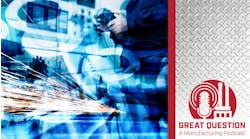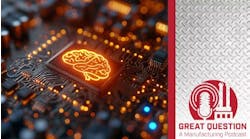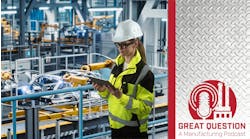Podcast: Additive manufacturing and bridging the gap between prototypes and production
In this episode, Robert Brooks, editor-in-chief at American Machinist, a sister brand to Smart Industry, delves back into additive manufacturing, analyzing the current state of the AM sector, after several years of organizational turmoil among top suppliers of additive systems.
Podcast: Has additive peaked or is the marketplace for 3D manufacturing simply shifting?
In his Great Question: A Manufacturing Podcast, Brooks argues that the turmoil in AM has had virtually nothing to do with processes or technology developments in the sector, adding that investors have been impatient with the rate of worldwide adoption of the 3D printing process.
Below is a partial transcript of this podcast:
This is the reason that Patrick Wirt’s article is relevant, particularly in the context of import tariffs, which many machine shops and other manufacturers may anticipate will draw more inquiries for their services. This article makes the case a current one but referencing factors that have been well established that adopting additive manufacturing and 3D printing has practical advantages that support and enhance established manufacturing operations.
I quote the author:
“Speed is one of the most significant advantages of additive manufacturing in the prototyping phase between product design and production planning. In conventional workflows, creating a single metal prototype may require days or even weeks, especially when toolpaths, workholding, and custom fixtures are involved.
“In contrast, AM allows same-day turnaround for functional prototypes, particularly when using polymer-based systems or metal binder jetting. Faster prototypes allow engineers to evaluate and revise designs early and often. This rapid iteration has several practical effects:
- Accelerated design validation: Get real-world feedback quickly without waiting on lengthy machine set-ups.
- Reduced bottlenecks: Design and development timelines can shrink significantly.
- Cost savings: Errors are caught earlier, reducing the risk of expensive late-stage redesigns.
"Machine shops using AM in tandem with CAD/CAM workflows can produce test parts overnight and run dimensional or functional checks first thing the next morning. This not only streamlines development cycles, but also:
- Increases shop flexibility for last-minute client changes.
- Improves throughput by minimizing downtime between design and machining.
- Builds client trust through faster response times and visible progress.
"Another important benefit of additive manufacturing is cost-efficiency at low volumes. Standard manufacturing often relies on economies of scale—producing a few parts can be disproportionately expensive due to set-up and tooling costs. Additive manufacturing sidesteps those costs by removing the need for custom tooling.
"Now, machine shops can offer small-batch or custom parts at competitive prices, filling a previously underserved niche. This capability is especially useful in industries such as aerospace, automotive, and medical devices, where low-volume parts may still require complex geometries and strict tolerances.”




